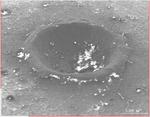
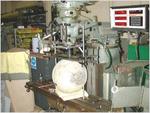
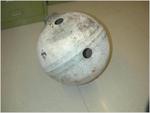
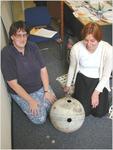
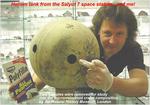
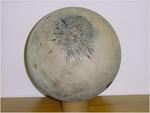
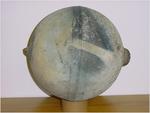
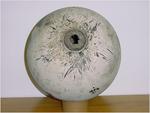
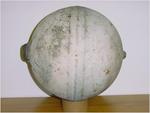
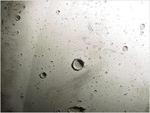
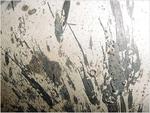
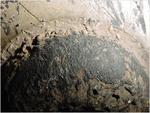
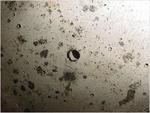
|
(root) / Salyut 7 - Kosmos 1686 Helium Tank Directory Index |
The 14 inch diameter, 7.4Kg, mostly titanium sphere is peppered with several hundred perfectly formed craters caused by tiny micrometeoroids which impacted on the surface during it's many years in space. Opposing ends have a mounting rod and a coupling/inlet valve respectively - each has ablated heavily during re-entry and streamers of molten material have been blown back onto the leading faces of the sphere, clearly showing the orientation of flight. Dark scorching on one side of the main body is evidence that the sphere "flipped" during flight as external mountings and couplings broke/ablated away, and for a brief few moments this side was the leading edge before orienting itself once more. This dark patch of side scorching also shows a much lighter coloured "shadow" band where another part of the spacecraft, or possibly the departing mounting rod, momentarily protected this part of the sphere from scorching.....and left an outline image of itself in the process.
Due to it's almost perfectly spherical shape and the high melting point of it's titanium chemistry, the main body of the sphere escaped complete ablation of it's surface, thus preserving the many micrometeoroid craters. However, the irregularly shaped mounting rod and the opposing coupling/inlet valve have a thick layer of dark fusion crust (!!) with fine flow lines that are similar to the surface of a freshly recovered iron meteorite.
Some of the crater "pits" were undoubtedly caused by other parts of the spacecraft that were ablating in front of the spherical tank during atmospheric passage and also by other man-made orbiting debris from earlier space missions that impacted during it's 9+ years in space......fine particulate matter such as paint flecks, booster vapours and even dumped astronauts' urine!!!!!
This tank has been the subject of much study with SEM research into the composition of the craters. A scientific research paper entitled: "Analysis of Impact Residues on Spacecraft Surfaces: Possibilities and Problems" has been written about this Salyut helium tank and was presented at the 3rd European Conference on Space Debris, with a proceedings paper.












